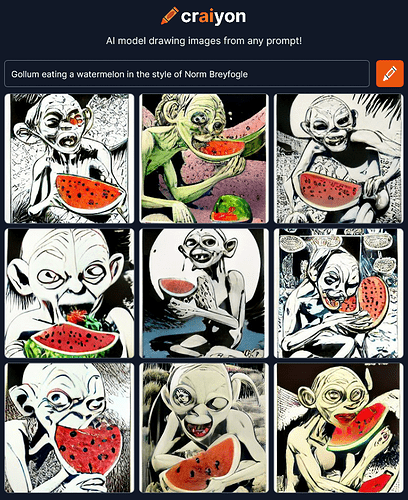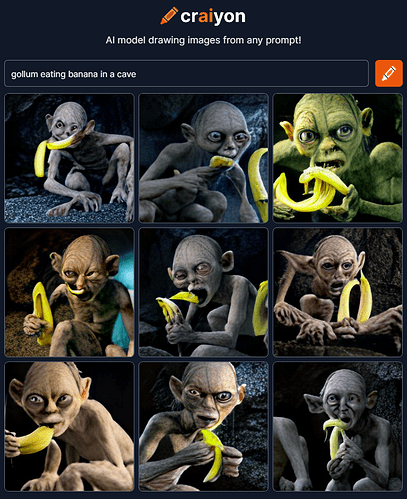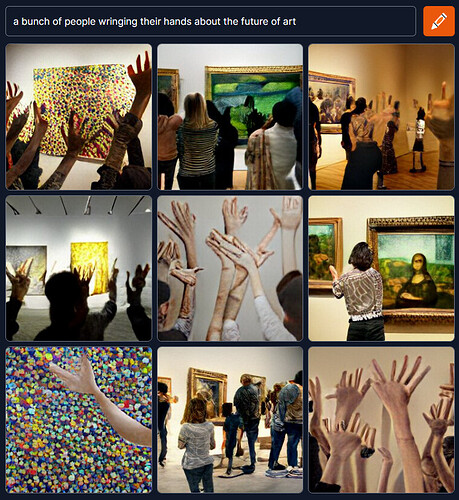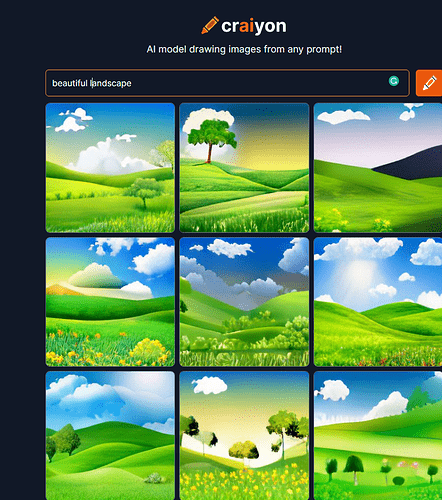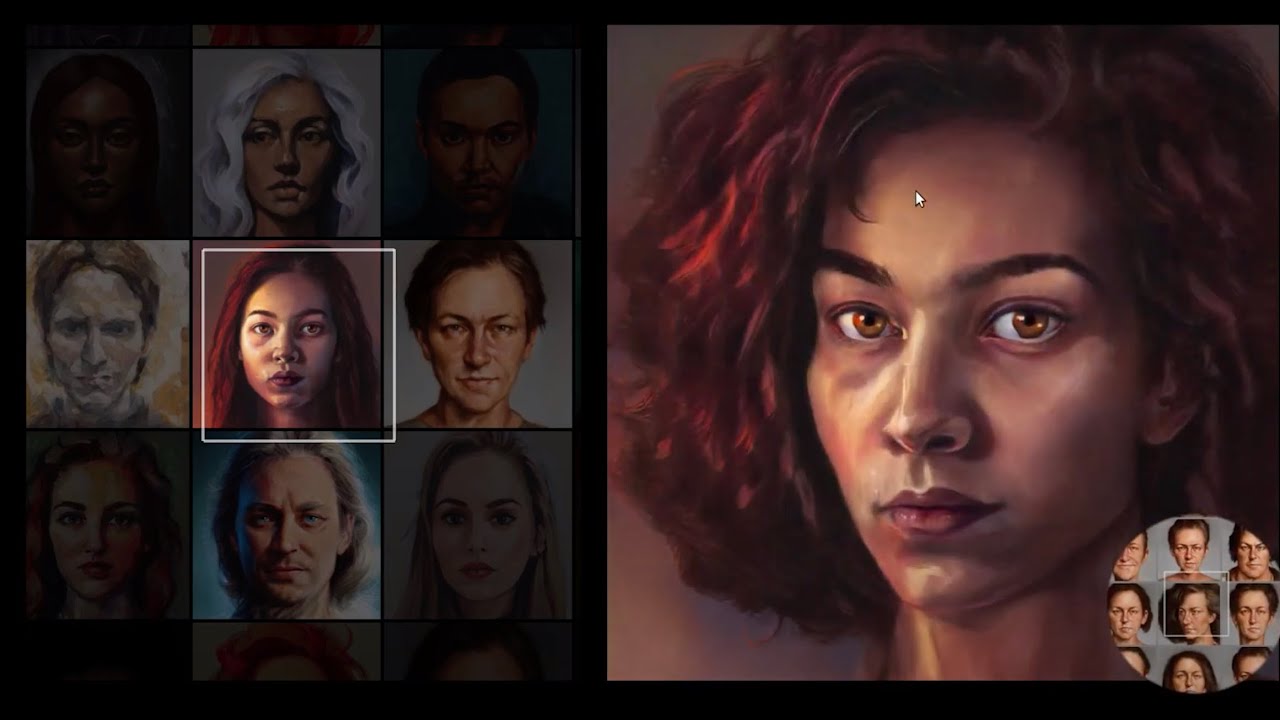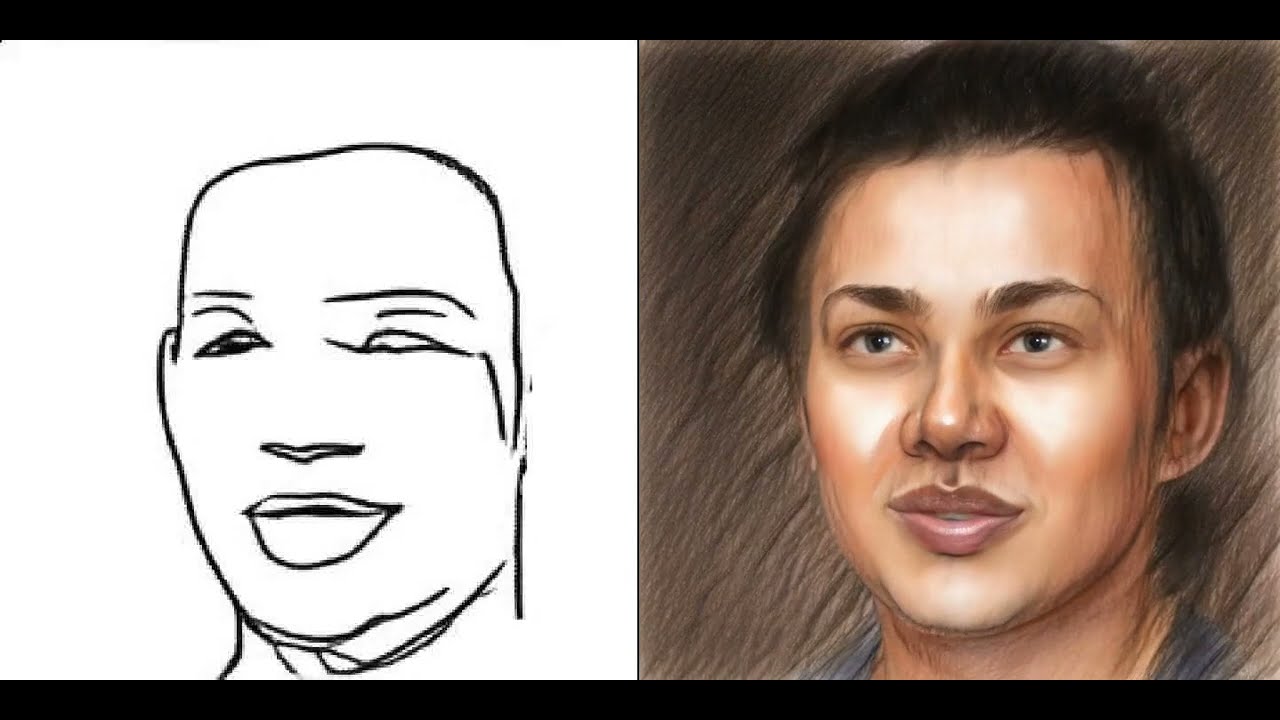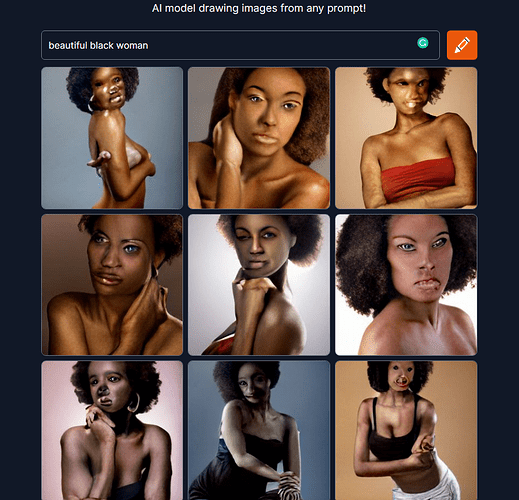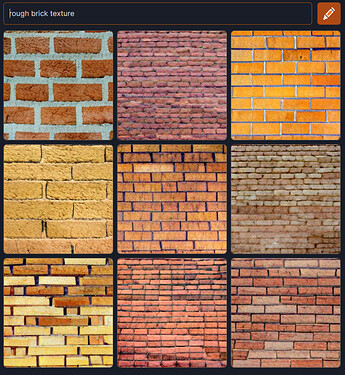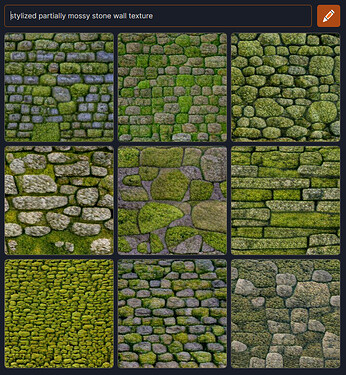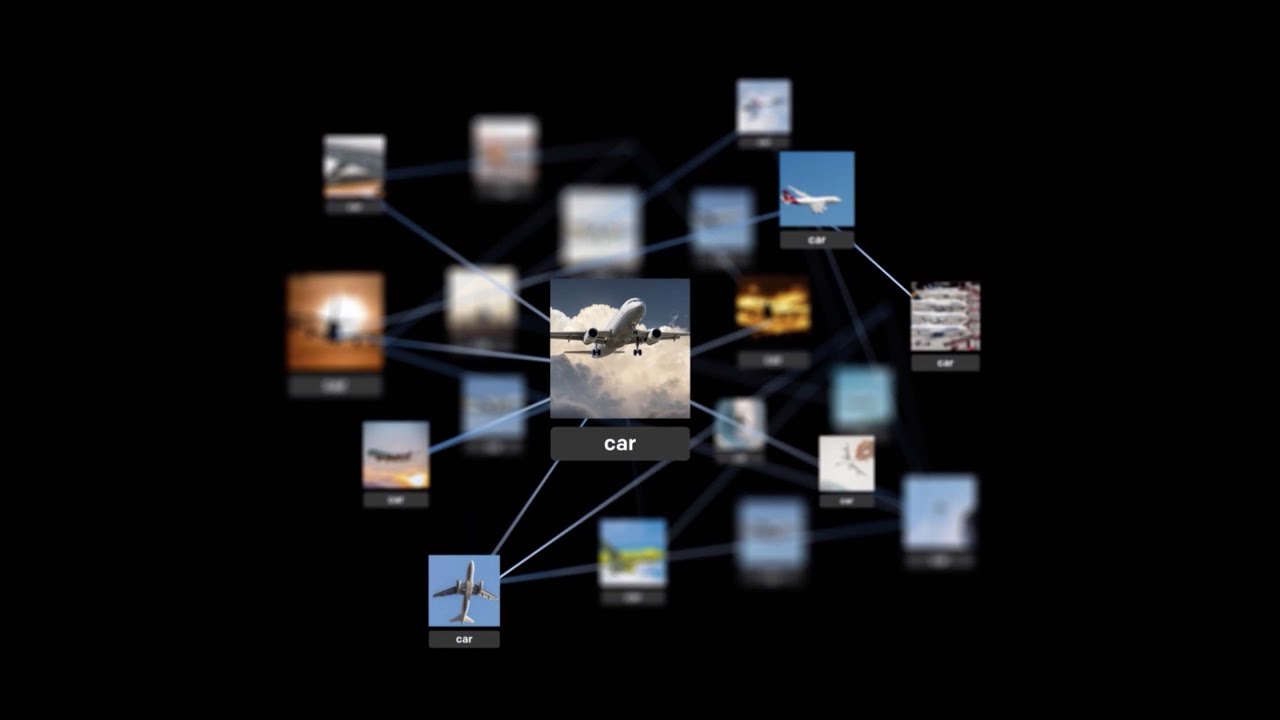If I’m not mistaken this is DALL-E mini. Full version is more powerful and gives better results. That’s why access to it is restricted. Google’s Imagen is perhaps even better. Machine learning will change the market for artists undoubtedly.
Exactly! ![]()
This (and the watermelon) is such a great example of how AI perfectly understands how to replicate any given concept, but fails to make meaningful connections between concepts. This AI obviously knows what “eating”, “cave”, “banana”, and “Gollum” mean, but it does not understand how “eating banana” should be different from “eating watermelon”. I mean, sure, it’s trying to understand, but it’s failing miserably.
Really, at this point, these AIs are a fancy Google image search + a fairly basic Photoshop neural image combination/background replacement filter. They can give you any random images you want, but putting them together artistically or contextually consistently fails. It’s almost like the ability to create “art” requires an emotional level of sentience that can’t be re-created with pattern-replication software ![]()
You can really see what I mean when you move beyond throwing nouns at this and start tossing adjectives in. AI is great at nouns, nouns are specific, pattern-based things. Adjectives? Not so much. For example, apparently only white, brunette, women with brown eyes, tan skin, and white tank tops are beautiful:
Personally, I think that looking like Jennifer Lopez, or a Dove commercial, isn’t really a great standard for “beautiful”. At the very least, it’s a remarkably boring one.
Let’s try a slightly different angle:
Yeah, I’m not worried about AI, and I never will be.
Again, this is a simplified version of the project. Results are vastly different depending on computing power and training material. And we are only at the beginning of this revolution. AI has zero problem with generating beautiful women:
Pretty much this is a very accurate description. The very first primitive image generators were literally copy-pasting objects ontop of images. They had the ability to extract image regions based on object recognition (eg: banana object + gollum object).
I think that the greatest innovation was the style transfer. That is another neural technique, that is supposed to apply one artistic style on top of another irrelevant style. This is more or less what makes the entire thing to become really practical and feasible.
Eh… that’s a strong statement with not much behind it. You have your video, I have my AI cookie-cutter discount deodorant model results. I admit there’s potential for improvement, but AI absolutely has a problem with generating beautiful women. It can’t even generate a woman that looks like a human, in my experience.
My main point with that example prompt is that AI can’t generate visually interesting results, that show any level beyond basic pattern regurgitation. You would get better results by googling “beautiful woman”, picking ten images at random, and blurring them together with a neural filter. This, it’s worth noting, is exactly what the AI is doing, except it’s doing it the hard way by generating from scratch.
For example:
All of these women have the same hair, which doesn’t even come close to representing the range of hairstyles you can have with this hair texture. They also all have the same skin tone, face shape, and, for some reason, the same black dress/tank top. This isn’t art. This is regurgitation, it’s a not-very-remarkable technical demonstration of pattern recognition.
Yes, AI will make a lot of technical aspects of art easier, but I have yet to see a video, read a paper, or encounter anything else that makes me believe AI will ever replace humans in an artistic sense. I say this as someone who has studied “AI” (a catchy misnomer for neural networks) quite a bit. I’ve read the papers, played with the math, I’ve very familiar with the backend of this stuff. At the end of the day, it’s just extremely intensive pattern recognition processing
But this one is the bad one and the good one is waaaay better and solves all problems.
I just saved @Tvaroog some time
If this thread were titled “digital art - is traditional art in danger?” it would seem pretty silly, no?
Again, you’re using a free web based toy version of this technology. It took you what, a minute to generate this image?
But they don’t have all the same clothes? Besides, if you want a different style just define it. Yes, AI is using existing images as a training data, so what. The result is what will matter.
People still use MS paint to make art.
The availability of better tools doesn’t always negate the previous tools that have been used for years.
I’m certain there are still some diehard blender 2.49b users on this very forum.
In many of the workshops I’ve done the presenter first spends time looking for reference images on the chosen theme. If AI generated art gets included here due to some quirky feature, unusual juxtaposition or interesting colour scheme, then AI will be influencing the art that real people are making, perhaps without them even knowing it.
I’ve already been using dall-e for inspiration images. I think that is a great use case for it.
I’m a big burger fan, and I had an idea of burgers growing on a tree like apples. I wanted to see if dall-e could generate an image to match, but what it came up with was not what I was expecting:
Burgers growing out of the tree like a bracket fungus is pretty cool, and I definitely felt inspired to play with that idea.
Unexpected inspiration isn’t a new thing, to be sure, and ai generated images can certainly be hit and miss as inspo, but it’s another tool in the toolbox. I’m certainly not afraid to use it. I have no delusions that my creativity is purely mine and not influenced by any outside forces, lol
I also found it’s not a bad tool to create quick textures. This is the type of thing you might find and download for free on a website anyway.
It’s also possible to get matcap textures, but it’s extremely difficult to tell it that a matcap is not a shiny baseball cap:
Here’s what I got after an hour of weeding out results and trying different descriptions (and these are only the good ones):
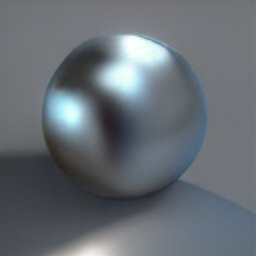
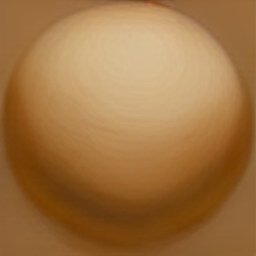

I see a use for it, and although it’s a limited one, it can be useful it certain cases. But I see it more as a tool for creating the small components that we use everyday anyway. It’s use in creating an entire artwork from scratch is even more limited, and I don’t see it getting any better than artists in the long run.
Here’s the thing, no matter how smart it gets, if it uses the internet as a source, it will be as dumb as the internet itself. Sure, it can create images that can pass for photorealistic, but they lack composition and other artistic values. Certain things hit a wall, where it cannot create different results no matter what you tell it. There’s just not enough information on that subject apparently.
Not to mention the racism, sexism, and negative stereotypes all over the internet. Would a news company leave their thumbnails in the hands of a racist and sexist robot, or would they at least hire someone to sort out the bad images?
Or, even better, might they hire a real artist (or 50) to train a custom network, tailored to their needs?
Remember this is just the start.
DALL-E 2 is awesome nothing is comparable with at this time, but other research in the future will come out and they will be a game changer many artist will use, but for sure we lose skilled people. This tools can be useful in many ways.
The video is mind blowing
And just for fun, this is the “ultimate doom of humanity”.
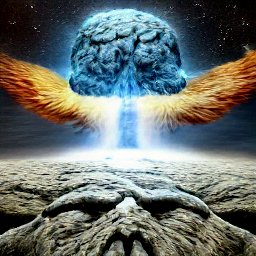
Yes. One day, we are all going to be killed by a giant flying brain.
When there are big improvements made to cycles, or when you get a hot new gpu, your rendering times go way down. Then, almost immediately, you crank up the quality, add more instances, higher res textures and you get pretty close to where your render times were before, but with much higher quality.
The same thing is true in major CG productions, whether they be film, games, or whatever. A hot new tool comes out, making a part of the process so much faster. Does the producer immediately fire 70% of the staff because the remaining people can complete the same level of quality in a reduced amount of time? Not really. They crank up the details roughly in proportion to the potency of the upgrade and you’re right where you started, but with much higher quality.
The cost of software licensing pales in comparison to the cost of paying artists. Even with very powerful tools, you still need to pay artists/technicians to use them. Do you see a world where AAA games can be produced for $50k? no. you are still going to need a huge team of artists to make the 100 gigs of textures in that game.
will AI tools help? absolutely. Will they reduce the amount of people working in the industry? maybe on the long term, but change takes time. Rome didn’t burn in a day.
Change happens in every industry and adaptation and change is just a part of being human.
